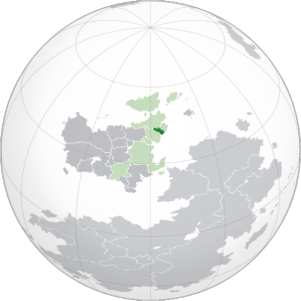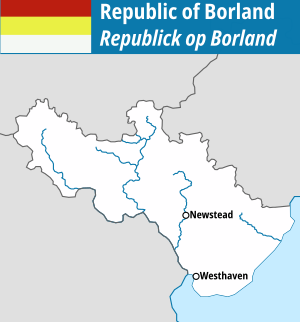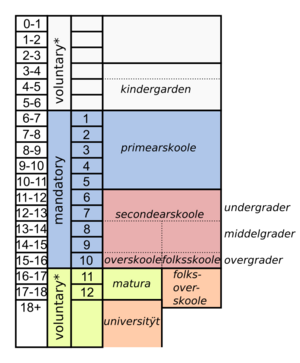Borland (Kylaris)
This article is incomplete because it is pending further input from participants, or it is a work-in-progress by one author. Please comment on this article's talk page to share your input, comments and questions. Note: To contribute to this article, you may need to seek help from the author(s) of this page. |
Republic of Borland Republick op Borland Republik Borland | |
|---|---|
 | |
| Location | Borland (dark green) within the Euclean Community (light green) |
| Capital and | Newstead |
| Official languages | Estmerish |
| Recognised national languages | Borish Weranian |
| Recognised regional languages | Azmaran Low Weranian |
| Demonym(s) | Borish, Borlander |
| Government | Unitary parliamentary republic |
| Area | |
• | 68,239 km2 (26,347 sq mi) |
| Population | |
• 2020 estimate | 7,125,000 |
| GDP (nominal) | estimate |
• Total | $513.5 billion |
• Per capita | 41500 |
| Gini (2020) | 27.8 low |
| Currency | Euclo (EUC) |
| Date format | dd/mm/yyyy |
| Driving side | right |
| Calling code | +43 |
| Internet TLD | .bo |
 | |
Borland (/ˈbɒrlænd/; Borish pronunciation: /ˈbɔːrland/, Weranian pronunciation: [ˈbɔɐ̯lant] (Werania), [ˈbɔ(ː)rlɑnt] (Borland)), officially known as the Republic of Borland (Borish: Republick op Borland, Weranian: Republik Borland), is a country in Eastern Euclea, which is bordered by Estmere to the south-west and west, Werania to the north, Azmara to the north-east and the Gulf of Assonaire to the south. The capital and largest city of Borland is Newstead, other major cities including Westhaven, Olham, Stunhill, Outhall and Werlaigh.
History
• Marauder Age
• attempt by Richard I of Estmere to secure Borland, defeated 1050 → formation of league, acceleration of unification
• personal union with Estmere
• Great War (de facto autononomy with fall of Estmere (temporary), and independence 1936 (after referendum))
• decentralization (of government), secularization (of the state), liberalization (of society), modernization (of the economy)
• move from traditional parties (conservatives, nationalists, democratic socialists) to “new” parties (ÞC, GPB, þnS)
Geography
Borland is located in Eastern Euclea on the coast of the Gulf of Assonaire, spanning from the coastal plains of Hethland in the east via the plains and hills of the centreregions to the hills, valleys and mountains of the northwestern regions of Finstria and Burgh. The country is bordered by Estmere, Werania and Azmara.
Major rivers include the River Aire, which flows from Finstria through Norland and the Midlands to the south of Newstead and to the Lowlands, where it flows into the Gulf of Assonaire at Westhaven, the River Leith, which flows through Maynes–Yord and the Midlands before joining the River Aire just south of Newstead in Brigge, the River Haer which divides Hethland into what was historically North Hethland (Azmaran) and Hethland proper (Borland), before flowing into the Gulf of Assonaire at Newdune, and, the rivers Linn and Wader, which flow through Burgh. Furthermore, parts of the River XX together with the River Dover (which splits into the Upper Dover through Maancester and the Lower Dover through Yord as one goes upstream) form around half of the Azmaro-Borish border, while the wikipedia:River XZ forms part of the border with Estmere.
Borland lacks lakes of significant size, although there are several hundred smaller lakes, most notably in Maynes–Yord (whence the Borish name for Maynes: Manneghlaak). In Finstria and Burgh, especially in the formerly separate yend of Bergland, there are many smaller dams and resevoirs, the largest one being close to the stead of Werlew.
Climate
The climate of Borland is typical for northeastern Euclea.
Environment
Politics and Government
Political Parties
Main article: Political parties in Borland
Administrative Divisions
Main page: Administrative divisions of Borland (Kylaris)
Prior to the administrative reform of 1970, Borland was divided into three regions, which were divided into a total of fourteen yends, which were further subdivided into municipalities (cryes (counties) and steads (cities)). With the 1970 reform, the regions alongside the regional branches were, for the most part, abolished. Furthermore, several yends were combined, bringing the total number of yends down from fourteen to seven.
Military
Borland has a comparatively small military, officially referred to as “Army of the Republic of Borland” (Borish: Armië þer Republick op Borland/Armië op þe Republick op Borland, Weranian: Armee der Republik Borland) or simply “Army of Borland”. After independence, it was created to ensure the sovereignty of Borland, though the country started demilitarizing during the 1940s. Since the beginning, the Borish military has been a professional army, with conscription never having been implemented and having been specifically ruled out in 1984. Currently, it stands at around 2,500 active servicemen, though that includes not only soldiers, but also doctors and nurses, amongst others. They are most known for their work as national guard, border control and, formerly, as riot police.
Foreign Relations
Economy
Energy
Industry
Infrastructure
Transport
Demographics
| Rank | Yend | Pop. | Rank | Yend | Pop. | ||||
|---|---|---|---|---|---|---|---|---|---|
| 1 | Newstead | Midlands | 1,150,000 | 11 | Newdune | North Hethland | 95,000 | ||
| 2 | Westhaven | Lowlands–South Hethland | 460,000 | 12 | Manham | Midlands | 87,000 | ||
| 3 | Olham | Midlands | 376,000 | 13 | Waderham | Burgh | 80,000 | ||
| 4 | Stunhill | Norland | 340,000 | 14 | Brigge | Midlands | 77,500 | ||
| 5 | Outhall | Maynes–Yord | 257,000 | 15 | Thrayn | Finstria | 76,500 | ||
| 6 | Lewen | Midlands | 165,000 | 16 | Berlaw | Norland | 75,000 | ||
| 7 | Ledge | Midlands | 147,000 | 17 | Fellham | Midlands | 74,000 | ||
| 8 | Werlaigh | Finstria | 145,000 | 18 | Yulleigh | Midlands | 67,000 | ||
| 9 | Aldenaw | Lowlands–South Hethland | 116,000 | 19 | Reckhouse | Burgh | 65,000 | ||
| 10 | Towenwey | Midlands | 104,000 | 20 | Syegaire | Finstria | 64,000 | ||
Borland is inhabited by over 7.1 million people, more than one seventh of which living within the capital of Newstead itself (1,105,000 people), with another 640,000 people living in adjacent cities and towns, adding up to a total of 1,790,000 people (just over 25% of the population) within the Newstead-Lewen conurbation.
There are ten cities in Borland with a population above 100,000, which have a combined population of 3.26 million people (or ca. 45.75% of the population). There are a further nineteen cities with a population above 20,000, which have a combined population of ca. 1.15 million people (or ca. 16.1% of the population), and twenty towns with a population between 10,000 and 20,000, which have a combined population of 315,150 people (ca. 4.4% of the population). In total, there are 51 cities and towns with a population above 10,000, inhabited by ca. 4.725 million people (about 66.32% of the population).
Demographically, several splits between different population groups can be observed within Borland. The most significant of these include the ethnolinguistic split of Borland (into Estmerish, Borish and Weranian) and a split on religious boundaries. Historically, this was within Sotirianity into the Amendist and Catholic churches, though a variety of (Amendist) Free Churches have been founded since the early to mid 20th century.
Languages
At 34%, Estmerish is the most widely spoken primary language in Borland, followed by Borish. There is a strong discrepancy in the relationship of Borish and Estmerish as primary languages and as native languages, with 56% of inhabitants of Borland claiming Borish as their native language (many of whom say they grew up bilingually, mostly speaking Estmerish as a first or second language), while less than 30% claim to speak primarily Borish. This figure is the opposite for Estmerish, with 38% stating to speak Estmerish natively, but with 65% claiming to speak it as primary language in their everyday lives. 28% of Borish nationals speak primarily Weranian, with only 2% primarily speaking the fourth recognized language of Borland, Azmaran.
Most Borish are proficient in at least two of the four national languages, many also being proficient in at least one foreign language. 90% of Borish claimed to be fluent in Estmerish, rising to 96% in provinces other than Finstria-Burgh, with 60% being fluent in and a further 26% saying they have at least conversational knowledge of Borish. With the national languages (Estmerish, Borish, Weranian and Azmaran), most speakers speak local dialects of a given language rather than the standard form in their everyday life, with the proficiency in the standard form of the language varying across the country, but moreso across social classes.
The most common foreign languages other than Estmerish to be studied in Borland are Estmerish, Gaullican and Weranian, with students typically being most proficient in Estmerish, and in the north, also in Weranian.
Religion
Education
Main page: Education in Borland
Education is universally accessible and mandatory for ages six to sixteen (or years 1 to 10). The school system is divided into primary schools (years 1–5) and secondary schools (years 6–10), later into universities and professional schools which vary in length of schooling. Generally, schools in Borland are public since private schools had been temporarily banned after the country’s independence and only few private schools have opened since. Private kindergartens (including pre-schools) are widespread, however.
Primary schools (Borish: primearskoole(n)) are the first level of public education in Borland, with years 1 to 5 being nearly identical in all schools across the country in terms of the curriculum. One of the differences between primary schools is language education, with school children usually being instructed in their native language if available. Attendance of primary schools is mandatory starting with age six, with children who will have turned six over the course of the first semester of a given school year usually still being included, thus starting to go to school at age five.
Secondary schools (Borish: secondearskoole(n)) are subdivided into two types, both of which go from year 6 to 10. Years 6 and 7 are called “undergrades” (undergrader), years 8 and 9 are “middlegrades” (middelgrader) and year 10 (depending upon definition as well the years 11 and 12) is referred to as “overgrades” (overgrader). Attendance is mandatory until grade 10, or, until one reaches the age of 18 (though normally, students graduate from secondary school at age 16). Graduating from secondary school, students have to pass an array of exams at the end of year 10 which are called “general comparative exam” (GCE for short). Most professions require a GCE certificate, oftentimes passed above a set minimum mark and in specific subjects, and passing GCE with an average of 05/15 or better is required in order to be permitted to pass on to years 11 and 12, thus being a requirement for the matura exams.
Matura is a qualification granted after successful exams at the end of a two year period (years 11 and 12). Students pick five courses as their “matural courses” (Borish: maturalcurs(er)) which have between five and six lessons a week and in which they will write exams. Furthermore, students have to pick several other courses which typically have either two or four lessons a week so that they reach a minimum number of weekly lessons which varies between yends. Students are usually allowed to change their courses, especially matural courses, if they regret their earlier choices. Similar to the GCE exams, 05/15 is the passing mark in matura exams, although (in contrast to the GCE certificate) one is not allowed to fail one of the subjects. Students who fail one or more exams have the possibility of retaking a given exam up to twice. The primary exam dates and the exams themselves are the same across Borland, while the exam dates for those who failed the first exam or could not participate are chosen by any given school, albeit within a rough time frame provided by the ministry for education. After matura exams, students in year 12 no longer attend school, but have to wait until every exam is graded, with the matura certificate being handed out at the end of the school year before summer holidays. Those who failed and have to retake an exam may, however, have to wait much longer.
Universities
Professional schools (Borish: folksoverskoole(n)) are typically attended after receiving a GCE certificate, although it is often not necessarily required and many students have attempted or even passed matura or have been to university. During usually two or more years, students are taught a profession, which usually includes exams at the end of each semester and internships.
Other forms of education most prominently include paid internships and apprenticeship (grouped together as “payed education”), usually in private companies. For some professions, these are an alternative to professional schools or might be used in-tandem, although this depends on a given profession.


